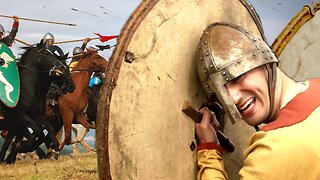Premium Only Content

Tale of the Dog - Atlantis Rising Research Group
Visit Atlantis Rising Research Group at https://www.atlantisrising.com/
The next time you train your dog to fetch a stick, and reward him with food, bear in mind that you may be participating in a very ancient bonding ritual. The fact that dogs seem to enjoy playing this way with humans could go a long way, some think, toward explaining why today we have so many different breeds.
In a study published in September, 2020 by The Royal Society, researchers claim the whole ‘man’s best friend’ thing probably started in Europe or Siberia about 20,000 to 30,000 years ago with wolves that liked to hang with humans for the food leftovers, and who learned, from puppyhood, how to interact with them. The new study tried to determine whether playful wolves could keep that trait for successive generations and found some evidence that they could. Thus, reportedly, began many millennia of learning to work and play together, and the eventual creation of hundreds of human-friendly breeds capable of everything from herding sheep to performing on stage.
But while that story may sound simple and straightforward, the big picture remains murkier. In 2012, the 33,000-year-old skull of a domesticated dog with a shortened snout and crowded teeth turned up in an Altai mountain cave in Siberia.
Another, find, equally old, in Belgium, also showed telltale signs of domestication. The last glacial maximum, when ice was at its greatest extent, occurred between 25,000 and 19,000 years ago. While it is not believed that domestication could have survived such a prolonged cold period, scientists have concluded that modern dogs are probably descended from multiple ancestors, helping to explain the differences between Chihuahuas and Rottweilers.
“Both the Belgian find and the Siberian find are domesticated species based on morphological characteristics,” said Greg Hodgins, a researcher at the University of Arizona’s Accelerator Mass Spectrometry Laboratory and co-author of the 2011 discovery report. “Essentially,” Hodgins said, “wolves have long thin snouts, and their teeth are not crowded, and domestication results in this shortening of the snout and widening of the jaws and crowding of the teeth.” As for how primitive people could have conducted some kind of massive breeding program requiring hundreds, or thousands, of generations to produce today’s many breeds, zoological science remains very much in the dark.
In his article “From Ferocious to Fido? (Atlantis Rising #92, March/April, 2012), science writer Stephen E. Robbins, Ph.D., argued that it would be far beyond difficult, if not impossible, to produce, by selective cross-breeding alone, within an interval of a few thousand years, what we find today—from Bulldog to Jackal; from Collie to Chihuahua. At some point in our ancient past, he wondered, was it possible that a now-forgotten genetic science left the clues that baffle modern research?
Is sophisticated engineering of some kind, or maybe more, responsible? In his 1976 best-selling book The Twelfth Planet, the late Zecharia Sitchin quoted Sumerian texts, claiming domesticated animals and plants were the work of the “gods” in the “house of fashioning” thousands of years ago.
“One of ‘Fido’s’ key features,” Robbins points out, “is a remarkable sensitivity to human cues, gestures and body language.” Dogs do better at this than chimpanzees, even though chimps are more intelligent. Dogs understand that a human’s gaze at a box might indicate food. Chimps will notice the gaze, but not understand the meaning.
This means, some think, there might be some special neural capacity in dogs to recognize and decode the facial expressions and cues of humans. There could be another, even more interesting explanation for the phenomenon. Monique Udell and colleagues at the University of Florida in a 2011 study for the journal Learning & Behavior, concluded that canines are probably born capable of reading their owners’ minds. The study compared the ability of domestic dogs and wolves to read the intentional state of humans regarding willingness to offer food.
Both groups were successful, but domestic animals accustomed to human behavior did better. Udell, thought subtle ‘attentional cues’ might be involved, but she conceded that the animals might have acquired the ability to read human minds.
-
 0:19
0:19
Atlantis Rising Research Group
2 years agoJoin the ATLANTIS RISING RESEARCH GROUP!
1.13K1 -
 1:17:59
1:17:59
Sarah Westall
13 hours agoDOGE: Crime & Hysteria bringing the Critics & the Fearful - Plus new CDC/Ukraine Crime w/ Dr Fleming
85.6K8 -
 45:39
45:39
Survive History
19 hours ago $10.98 earnedCould You Survive in the Shield Wall at the Battle of Hastings?
81.3K6 -
 1:50:28
1:50:28
TheDozenPodcast
18 hours agoViolence, Abuse, Jail, Reform: Michael Maisey
114K5 -
 23:01
23:01
Mrgunsngear
1 day ago $6.81 earnedWolfpack Armory AW15 MK5 AR-15 Review 🇺🇸
97.2K12 -
 25:59
25:59
TampaAerialMedia
1 day ago $4.58 earnedUpdate ANNA MARIA ISLAND 2025
62.3K4 -
 59:31
59:31
Squaring The Circle, A Randall Carlson Podcast
20 hours ago#039: How Politics & War, Art & Science Shape Our World; A Cultural Commentary From Randall Carlson
47.5K3 -
 13:21
13:21
Misha Petrov
20 hours agoThe CRINGIEST Thing I Have Ever Seen…
39K75 -
 11:45
11:45
BIG NEM
16 hours agoWe Blind Taste Tested the Best Jollof in Toronto 🇳🇬🇬🇭
28.2K1 -
 15:40
15:40
Fit'n Fire
19 hours ago $0.67 earnedArsenal SLR106f & LiteRaider AK Handguard from 1791 Industries
24.1K1